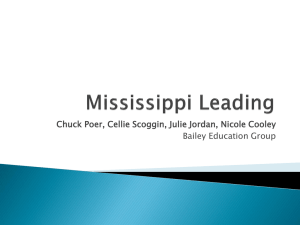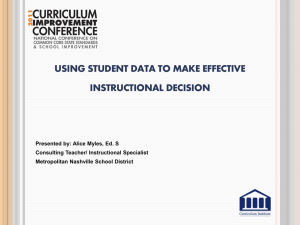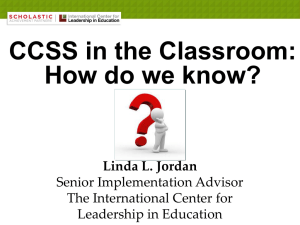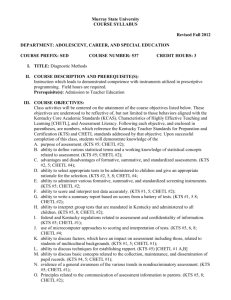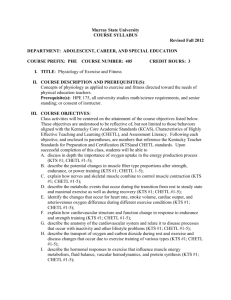Jessica Addison/Ken Mattingly
advertisement
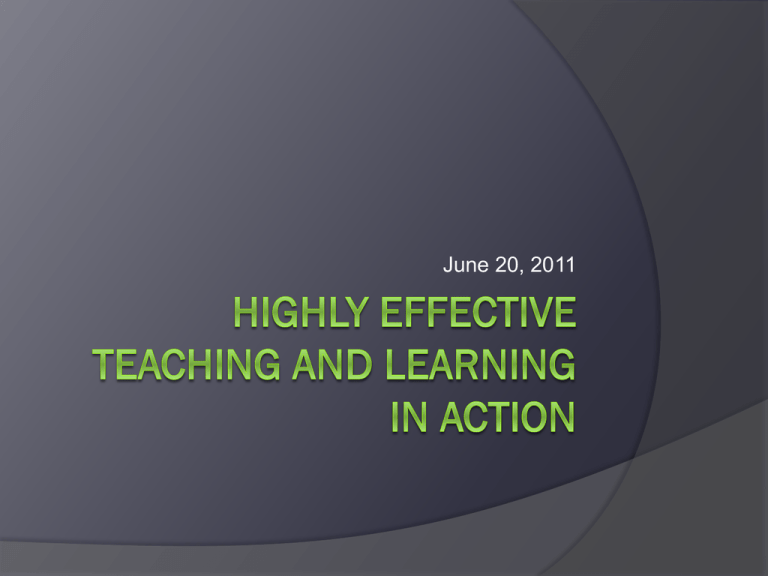
June 20, 2011 Your Presenters Ken Mattingly – Rockcastle County Jessica Addison – Todd County/KDE Session Targets I can develop a deeper understanding of each section of Characteristics of Highly Effective Teaching and Learning. I can identify evidence of Characteristics of Highly Effective Teaching and Learning. I can analyze classroom situations for incomplete indicators of Highly Effective Teaching and Learning. I can make connections between Highly Effective Teaching and Learning and High Quality Implementation of Formative Assessment. I can make a plan to use formative assessment strategies to guide teacher improvement and drive student achievement. School and district leadership will only be able to achieve high quality instruction and continuously improving academic achievement if they galvanize effort around a shared vision of what constitutes high quality teaching, learning, and content, set ambitious goals with monitoring and feedback systems to achieve this vision, and construct all elements of their organization to facilitate rather than constrain success. – KDE Theory of Action Instructional Rigor & Student Engagement Knowledge of Content Instructional Rigor & Student Engagement Learning Climate Knowledge of Content Instructional Rigor & Student Engagement Learning Climate Knowledge of Content Instructional Relevance Instructional Rigor & Student Engagement Learning Climate Knowledge of Content Instructional Relevance Classroom Assessment & Reflection Instructional Rigor & Student Engagement Jigsaw Count off at your table 1-5. Individually, or with a partner, read the correlated section of CHETL. Compare the text to the list you created. Answer the following questions: Before reading CHETL, I(we) thought: Now, I think: Common Misconceptions Authentic Engagement Levels of Engagement Common Misconceptions Authentic Engagement Empowering Activities Collaborative Work Meaningful Questions Others? Question to Consider How has my definition of Highly Effective Teaching and Learning been crystallized or refined? CHETL Section Learning Climate Classroom Assessment & Reflection Instructional Rigor & Student Engagement Instructional Relevance Knowledge of Content Descriptor Evidence Question to Consider Which descriptors or partial descriptors will be difficult to observe? Why? enjoy your Ambiguous Descriptors What CHETL descriptors will require more information upon which to make a judgment? What kinds of evidence will you need to gather to make an informed decision? Lets look at an example from the Student Characteristics section of Learning Climate: takes educational risks in class. First Video Clip Observations vs. Inferences What evidence is there for students taking educational risks in class? Students working with materials They seem to be hypothesizing Taking freedom to explore What further evidence would we need to know if educational risk-taking is really going on? Discussion with students Samples of student work Further observations of the class Teacher Indicators Examine the following video and find something in the HETL indicators that shows up as incomplete. What other evidence do you need? How would you collect that evidence? Second video clip Think – Pair - Share Examine your CHETL descriptors and determine one that you saw evidence of in the video, but are not sure if it was clearly demonstrated. Decide what further information you’d need to conclude if it was met. Turn to someone at your table and share your thoughts. Possibilities Learning Climate – students participating in empowering activities? Assessment – was it used formatively? Rigor and Engagement – students challenged to think deeply? Relevance – student experiences, interests, and real-life situations incorporated? Content – promotes understanding of vocabulary? Other Uncertain Indicators Examine the indicators identified as tricky in your packet. Select a minimum of two and determine the evidence you’d need to make a clear judgment. Share your thoughts with your table. What are the commonalities within these indicators? What do they ultimately require from administrators? Question to Consider What language from the CHETL document might need to be clarified in my school/district? Students will only be able to learn and apply the knowledge, processes and skills defined by Kentucky standards if they are effectively engaged with challenging content under the guidance of a skilled, knowledgeable and responsive teacher who holds them to clear, high expectations. – KDE Theory of Action Formative Assessments are . . . . . . the assessments that we conduct throughout teaching and learning to diagnose student needs, plan our next steps in instruction, provide students with feedback they can use to improve the quality of their work, and help students see and feel in control of their journey to success. Stiggins, et al. Formative Assessment Where am I going? 1. Provide a clear and understandable vision of the learning target. This is more than posting the targets on the board. Students should have ownership of the learning targets and all instruction should mirror the learning intention. 2. Use examples and models of strong and weak work. By using anonymous work, students have a vision of what quality is and is not. By analyzing the difference between strong and weak models, students become more proficient at analyzing their own. It is important to model the development and revision cycle as well so that students can see the value in the messy part. Where am I now? 3. Offer regular descriptive feedback. Feedback should reflect the learning target(s). A teacher is modeling the thinking students will need to engage in for self-assessment. 4. Teach students to self-assess and set goals. Identification of strengths and weaknesses in regards to the learning target(s) enables student to plan their next steps. How do I close the gap? 5. Design lessons to focus on one aspect of quality at a time. Learners benefit from addressing one aspect at a time keeping in mind that eventually all components must come together. 6. Teach students focused revision. Model the revision of a problem, then have students do the same. 7. Engage students in self-reflection, and let them keep track of and share their learning. This is more than sticker charts or points sheets! It is about growth and celebration. How is HETL connected to FA? Determine A/B As select a number 1-7 Bs select a number 1-5 Making Connections 1. 2. 3. 4. 5. 6. 7. Provide a clear and understandable vision of the learning target. Use examples and models of strong and weak work. Offer regular descriptive feedback. Teach students to self-assess and set goals. Design lessons to focus on one aspect of quality at a time. Teach students focused revision. Engage students in self-reflection, and let them keep track of their learning. A : Seven Strategies of Formative Assessment 1. 2. 3. 4. 5. Learning Climate Classroom Assessment & Reflection Instructional Rigor and Student Engagement Instructional Relevance Knowledge of Content B: Characteristics of Highly Effective T & L How is HETL connected to FA? Determine A/B As select a number 1-7 Bs select a number 1-5 A and B compare CHETL and the Strategy of Formative Assessment Describe how the two strategies/characteristics support one another. Make the Chain Question to Consider What is one new connection I have made between Highly Effective Teaching and Learning and Formative Assessment? Look at this guy! Similarly… Teachers, working alone, with little or no feedback on their instruction, will not be able to improve significantly—no matter how much professional development they receive. - Tony Wagner Feedback Cycles What are our expectations for improving student performance? How do we expect students to meet these expectations? Likewise, what are our expectations for teacher performance? Will they reach those expectations on their own? How can we scaffold their improvement? Teachers will only be able to engage students with challenging content in ways that produce effective learning results if they are supported with high quality, aligned instructional resources and with on-going, continuous opportunities to learn about, generate and receive feedback about, and reflect on the quality of their instruction and the work of their students within a school and district culture of clear, high, accountable expectations. - KDE Theory of Action Seven Strategies & Scaffolding Teacher Improvement Examine the seven strategies and their implications for student learning. Rewrite the strategy in words that apply to teachers and improving their performance in CHETL Use clear teacher-friendly language, such that expectations are well-defined Think about how these can give direction to teacher improvement initiatives Putting It into Practice Determine how you can implement each strategy. Include the supports needed for implementation with teachers. How is this similar to using the seven strategies with students? How is it different? Question to Consider Why should I utilize the Seven Strategies of Formative Assessment? Session Targets I can develop a deeper understanding of each section of Characteristics of Highly Effective Teaching and Learning. I can identify evidence of Characteristics of Highly Effective Teaching and Learning. I can analyze classroom situations for incomplete indicators of Highly Effective Teaching and Learning. I can make connections between Highly Effective Teaching and Learning and High Quality Implementation of Formative Assessment. I can make a plan to use formative assessment strategies to guide teacher improvement and drive student achievement.


